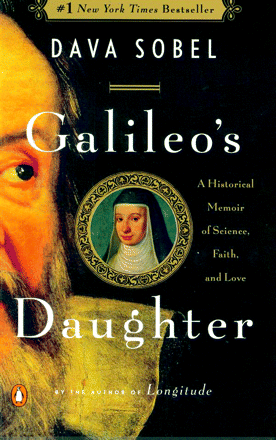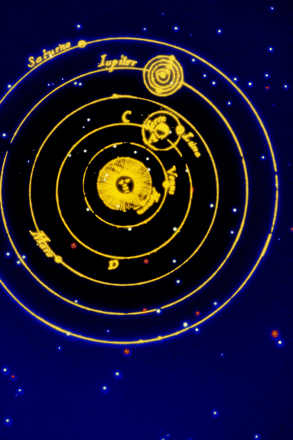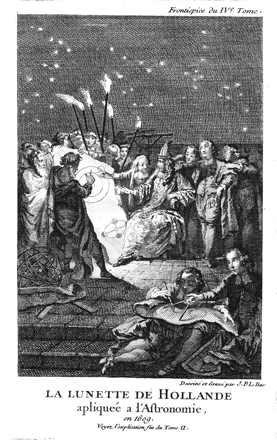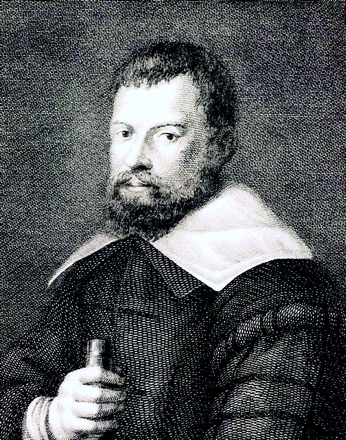Telescopic Hindsight
- Christie Carrico, PhD, Executive Officer for ASPET.
Galileo’s Daughter.

Dava Sobel. New York: Penguin; 2000. 420 pages. $14.00. ISBN: 01402805553
Galileo Galilei, arguably one of the greatest scientists in history, never married. Nevertheless, he had two daughters and a son with his Venetian mistress, Marina Gamba. Realizing that the conditions of their birth would not allow them to make advantageous marriages, Galileo entered both of his daughters into the cloistered Convent of San Matteo while they were still pre-teens. Both girls remained there, in poverty and seclusion, for the rest of their lives. Galileo was able to get his son, Vincenzio, legitimized by fiat from the Duke of Tuscany. But it was his eldest daughter, Virginia, and not his son, who shared in Galileo’s interest in science and astronomy.

Despite being physically separated from him from the age of thirteen, Virginia remained close to her father her entire life and corresponded with him almost weekly. The Convent of San Matteo of Arcetri lay in the hills outside of Florence where Galileo spent most of his life, so sending letters via the regular messengers who traversed the physical and spiritual distance between the convent and the city was a relatively efficient way to stay in touch. Galileo saved all of his daughter’s letters. He also wrote back regularly to Virginia, but these letters have disappeared. They were presumably destroyed, following Virginia’s death, by the Mother Superior of the Convent, who may well have been wary of possessing any documents likely to raise the attention of the Inquisition.
Galileo’s Daughter, by Dava Sobel, is the story of Galileo’s life, viewed through the lens of his daughter’s letters to him and augmented by his letters to various friends, priests, Popes, dukes, colleagues, and students. This biography thus offers an intimate look into the life of this extraordinary man, his discoveries, and the time in which he lived.
Virginia grew into an unusually bright young woman, interested in many of the same pursuits as her father, and it is her interest in, and recognition of, the study of astronomy that led her to choose her cloistered name—Maria Celeste. Had she lived in another time, she herself would probably have been an illustrious scientist. Under the constraints of her era and social status, however, she was relegated to a vicarious life in science, made possible by her father’s letters. She was also extremely ingenious. During the time Galileo was in Rome under suspicion of heresy and awaiting the fate handed to him by Pope Urban, Suor (Sister) Maria Celeste essentially managed her father’s country estate, despite not being able to leave the confines of the convent. Had she lived longer, it is likely she would have been selected as Mother Superior; however, poor attention to her own health led to an early death, at only thirty-four years of age.

Among Galileo’s many achievements, his invention of the telescope fundamentally—and literally—changed our worldview. Galileo became famous in his time for discovering the moons of Jupiter and measuring mountains on the moon. He dared to discard the Ptolemaic earth-centric theory of the solar system in favor of Copernicus’s theory of the planets revolving around the sun. Today it is easy to overlook Galileo’s sheer audacity in stating that the earth was not the center of our solar system, but his findings caused an unprecedented—and unrepeated—upheaval in church and state, philosophy and culture. The societal conflict that confronted Galileo because of his scientific pursuits contributed to the ruination of his health, the loss of much of his fortune, confinement, and the brutal censorship of his writing. Interestingly, Galileo remained a devout Catholic. He was able to reconcile his faith and his scientific observations without internal conflict—a type of reconciliation that the Church was unable to achieve until 1835, almost two centuries after his death.

Until the religious controversy that surrounded his work came to a head, Galileo had been able to publish most of his findings as carefully crafted “dialogues” between scholars, carefully presenting both sides of the issue with pros and cons. He spent an enormous amount of time writing and refining these publications so as not to offend the Holy See. Eventually, even this approach proved to be unacceptable, and in 1633, following months of detention in Rome, Galileo was forced, under threat of torture, to recant his views. His Dialogue on the Two Chief World Systems: Ptolemaic and Copernican was banned by the Holy Office of the Inquisition.
Only a matter of months after returning to his home outside Florence, under permanent house arrest, Galileo’s beloved daughter died, and during the next nine years, up to his death, he would suffer chronic illness, including blindness. In those nine years, however, he finished his treatise Two New Sciences, on the theory of motion that he had begun several years before. Although this manuscript contained nothing controversial, its publication was hindered by his interdiction from the Inquisition. In the seventeenth century, as most of Europe was under the dominion of Pope Urban, printers were not anxious to produce anything that would offend the Inquisition. Only through the efforts of his students and colleagues across Europe was a printer found who would print Galileo’s last, and possibly greatest achievement. Eventually, Elia Diodati, a lawyer friend of Galileo, engaged a printerwilling to undertake the job. (The printer’s name was Louis Elzevir!)
Galileo’s Daughter is not a new book. It was published in 1999 and was on the New York Times Bestseller list. For those of you who have already read it, you know what a gem is it. For the rest of us, it was (or will be) a pleasure discovering it. The end is very touching and even contains a surprise, not something you usually find in a biography of someone who has been dead for over three centuries. There are many other nice touches to the book as well. It is extensively referenced and provides end notes for each chapter, has a very complete index, includes illustrations, and provides the timeline of scientific and politico-religious events. This latter section, “In Galileo’s Time,” starts with Copernicus in 1543 and ends, appropriately, with acknowledgment of the reconnaissance mission of the spacecraft Galileo, which provided the first up-close views of the Galilean moons of Jupiter in 1999.
Dava Sobel is a former New York Times science writer who also wrote the highly acclaimed Longitude. She has an asteroid named after her.
- © American Society for Pharmacology and Experimental Theraputics 2007



